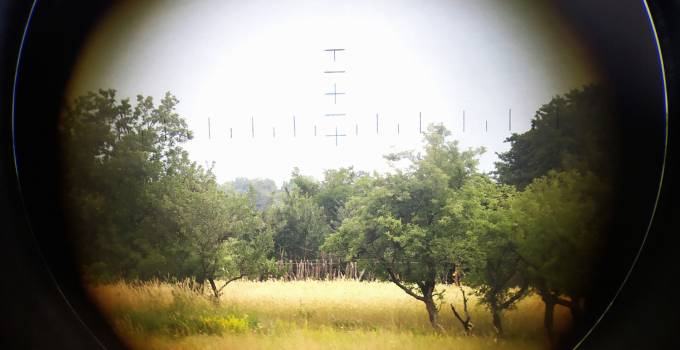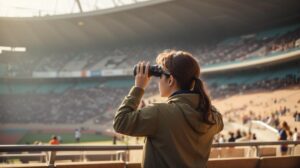Do you sometimes get confused about which binoculars to buy? That is probably because you do not understanding the binocular magnification. The main purpose of binoculars is to magnify objects. Binoculars are mainly used to make things appear bigger than they look to our eyes. They help us see distant objects up close.
People use binoculars for various purposes like hunting, stargazing, bird and wildlife watching. When it comes to understanding the binocular magnification the most important thing is how much they can magnify the object you are looking at.
By the end of this article you will be completely aware about the magnification of the binoculars.
What do magnification numbers mean on binoculars?
Each binocular is labelled with a number. The number could be like 7×35 or 10×50. These numbers tell you about the magnification of the binoculars and the size of the objective lens. It is important to understand what those numbers mean on binoculars.
In the first example of 7×35, the 7x magnification on binoculars means that the binocular magnifies seven times and objective lens is 35 mm wide. This means you can see things seven times bigger than with normal view from your eyes.
The second example of 10×50 explains that the binocular magnifies ten times and the objective lens is 50 mm wide.
Why binocular magnification is important?
The main purpose of binoculars is to help you see objects that are far away as if they were much closer. This is why binocular magnification is important.
When you use binoculars with 8x magnification, it seems like bringing objects 8 times closer to you as compared to looking directly at them with your eyes only.
How to Calculate Understanding the Binocular Magnification
Binoculars are like two telescopes put side by side. Your eye looks through one of them to see things bigger and with depth. You can calculate how much they magnify objects by using the focal length of objective lens and eyepieces.
Given below is a step by step process to measure the magnification of the binoculars.
Measure diameter of objective lens
The diameter of objective lens is mostly expressed as a figure on the eyepiece of binoculars, like 10×50. The first number represents the magnification power. The second number tells you the size of objective lens.
Obtain focal length of objective lens
Find out how long the lens is. You can find this information by looking on the company’s website. You can also find it out by reading the instruction booklet that comes with the binoculars.
The focal length of objective lens is approximately four times the width of the lens. So, for binoculars of 10×50 magnification, the focal length of lens is around 200 to 250 millimetres.
Calculate focal length of eyepiece
Measure the length of the eyepiece. You can get this information from the manufacturer’s website.
The width of eyepiece should be roughly the same as the size of a fully opened human eye. The width of fully dilated pupil is about 7 mm. So the length of eyepiece is approximately 25 millimetres.
Calculate binocular magnification
To figure out how much the binoculars magnify, divide the length of the objective lens of binocular by the length of the eyepiece.
You can express this as MA = fo/fe
Where,
MA (magnification)
fo (focal length of the objective lens)
fe (focal length of the eyepiece).
So for binoculars with length of objective lens 200 and length of eyepiece 25, the magnification would be MA= 200/25 = 8.
It is important to remember that the magnification of binoculars mainly depends on the size of the objective lens because the size of eyepiece is mostly fixed to match the width of a fully dilated eye.
How to choose binoculars magnification?
Binoculars with a 8-10x magnification are good choice for everyday use. Higher magnification can bring objects closer but the picture might not look as sharp and clear. When trying to know what magnification you need for binoculars, think about what you will do with the binoculars.
If you are going sailing, you might need waterproof binoculars. If you are looking at stars, pick a pair of binoculars that work well in the dark. Bigger binoculars with glass lenses and higher magnification power are usually better. But they can be heavier and more expensive.
What is the highest magnification on binoculars?
When we are talking about magnification of binoculars there is no fixed limit on how strong magnification for binoculars can be. In theory, you can make very strong binoculars. But practically there are few limitations due to how optics work.
The powerful space telescopes can magnify a thousand times. But to see details they need very large lenses. This is not possible for handheld binoculars. A magnification power of 160x is the most powerful magnification for binoculars. This means they can zoom in 160 times closer to the object that you are looking at in the distance.
Advantages and disadvantages of high magnification binoculars
High power binoculars are useful in several ways but they have some disadvantages too. Let’s go through some of the advantages and disadvantages related to high magnification binoculars
Advantages
- High magnification of binoculars can bring the object closer to you. You can see a detailed observation of the object from far away. It can be useful in birdwatching, wildlife viewing and astronomical observations.
- Long distance viewing can be easily done with the help of high power binoculars. Stargazing, sports events and landscapes give a perfect view through high magnification binoculars.
- Photographers can use strong magnification binoculars to see faraway objects up close. It helps them to take pictures of objects that are difficult to reach. These binoculars help photographers plan their shots and capture distant objects more easily.
Disadvantages
- When you use such strong magnification, it narrows your view. Due to this, it becomes hard to see a wide area like a sports event or concert.
- It is difficult to locate and follow the object you are trying to focus with high magnification binoculars. This is because the area of view becomes smaller.
- Higher magnification power increases hand movements which causes the image to shake. It becomes difficult to hold them steady for longer periods of time.
- When you use stronger magnification in binoculars less light comes in. This can make the images look dimmer, especially in low light conditions.
- Binoculars with high magnification are mostly big and heavy. It can become difficult for you to carry them along wherever you go.
What is the Lowest magnification on binoculars?
The lowest magnification for binoculars is usually around 6x to 8x. These binoculars give you a wider view. They are good for fast moving things. With these binoculars, it is easy to see a big area. They cannot zoom in very close but they are useful for lots of fun activities where you want to see a lot of things at once.
Advantages and disadvantages of low magnification binoculars
There are several useful as well as disadvantageous factors of low magnification in binoculars. Let’s discuss some of the advantages and disadvantages of binoculars with low magnification.
Advantages
- The low magnification binoculars provide a wide field of view. This is useful for activities involving broad view like sporting events, concerts, golfing and bird watching.
- Low power binoculars are excellent for tracking fast moving subjects. These are used in hunting because they can easily track running animals.
- You can easily scan landscapes with the help of low power binoculars. They give a steady view during long periods of watching.
- Low magnification binoculars are lightweight. This makes them easy to carry along.
- These binoculars do not make the image shaky when you hold them with your hands
Disadvantages
- Lower magnification binoculars can not zoom in very closely. This means you might not see all the tiny details when trying to view something far away.
- In situations where you want to see distant things very clearly, like observing wildlife, the lowest magnification binoculars might not be good enough.
- These binoculars will not show as many details as higher magnification binoculars. This is a disadvantage for activities like birdwatching or stargazing because you can not see fine details.
Which Is The Best Magnification For Binoculars?
Which level of magnification is best for you depends on the purpose you want to use your binoculars for. Mostly lower magnification gives you a brighter image and makes it easier to keep the view steady. For activities like birdwatching and wildlife watching, many people find that binoculars with 8x magnification are a great choice because they are good at zooming in and keeping the image stable.
5-7x magnification works good for sports and nature observation. If you are interested in watching animals or hunting you should go for binoculars with 8-10x magnification.
What magnification binoculars should I buy?
When deciding what magnification binoculars you should buy you should first decide for which purpose you want to buy the binoculars. Usually, low magnification binoculars are used for watching sports events and nature.
8x binoculars are perfect for many different purposes like bird watching and wildlife viewing. For hunting, 10x binoculars will be suitable for your use. If your binoculars do not have image stabilization then you should avoid using binoculars above 12x magnification. At 15x or more, the image starts shaking due to hand movements.
Even binoculars with 12x magnification require additional support like tripod for a steady image viewing. Different magnifications suit different activities so choose what fits your interests best.













